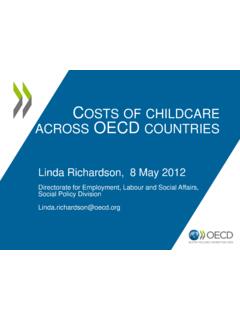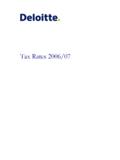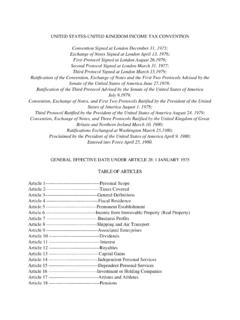Transcription of A survey of the UK tax system
1 A survey of the UK tax systemIFS Briefing Note BN09 Thomas Pope Tom WatersISBN 978-1-909463-68-4 Institute for Fiscal Studies, 2016 A survey of the UK Tax system Updated by Thomas Pope and Tom Waters* November 2016 Institute for Fiscal Studies Acknowledgements This briefing note is a revision of earlier versions by Stuart Adam, James Browne, Lucy Chennells, Andrew Dilnot, Christine Frayne, Charlotte Grace, Greg Kaplan, Thomas Pope, Barra Roantree, Nikki Roback and Jonathan Shaw, which substantially revised and updated the UK chapter by A. Dilnot and G. Stears in K. Messere (ed.), The Tax system in Industrialized Countries, Oxford University Press, Oxford, 1998.
2 The original briefing note can be downloaded from The paper was funded by the ESRC Centre for the Microeconomic Analysis of Public Policy at the Institute for Fiscal Studies (grant ES/M010147/1). The authors thank Stuart Adam for his help and advice during revision of the briefing note. All errors are the responsibility of the authors. *Address for correspondence: Institute for Fiscal Studies, 2016 2 Contents 1. Introduction .. 3 2. Revenue raised by UK 4 3. The tax system .. 6 Income tax .. 6 National Insurance contributions (NICs) .. 14 Value added tax (VAT) .. 17 Other indirect taxes .. 19 Capital taxes .. 24 Corporation tax.
3 28 Taxation of North Sea production .. 31 Taxation of banks .. 32 Council tax .. 32 Business rates .. 34 4. Summary of recent trends .. 37 How did we get here? .. 37 Personal income taxes .. 40 Taxation of savings and 49 Indirect taxes .. 56 Taxes on companies .. 61 Local taxation .. 63 5. Conclusions .. 65 Institute for Fiscal Studies, 2016 3 1. Introduction This briefing note provides an overview of the UK tax system . It describes how each of the main taxes works and examines their current form in the context of the past 35 years or so. We begin, in Section 2, with a brief assessment of the total amount of revenue raised by UK taxation and the contribution made by each tax to this total.
4 In Section 3, we describe the structure of each of the main taxes: income tax; National Insurance contributions; value added tax and other indirect taxes; capital taxes such as capital gains tax and inheritance tax; corporation tax; taxes on North Sea production; the bank levy; council tax; and business rates. The information given in these subsections relates, where possible, to the tax system for the fiscal year 2016 17. In Section 4, we set the current system in the context of reforms that have taken place over the last 35 years or so. The section examines the changing structure of income tax and National Insurance contributions and developments in the taxation of savings, indirect taxes, taxes on companies and local Much of the information in this briefing note is taken from the government s Information relating to tax receipts is from the Office for Budget Responsibility (OBR) s Economic and Fiscal Outlook published alongside the March 2016 Occasionally, sources can be inconsistent because of the different timing of publications or minor definitional disparities.
5 1 There is more information on historical tax rates on the IFS website at 2 See 3 See Institute for Fiscal Studies, 2016 4 2. Revenue raised by UK taxes Total UK government receipts are forecast to be billion in 2016 17, or of UK GDP. This is equivalent to roughly 13,500 for every adult in the UK, or 10,900 per Not all of this revenue comes from taxes: taxes as defined in the National Accounts are forecast to raise billion in 2016 17, with the remainder provided by surpluses of public sector industries, rent from state-owned properties and so on. Table 1 shows the composition of UK government revenue.
6 Income tax, National Insurance contributions and VAT are easily the largest sources of revenue for the government, together accounting for almost 60% of total tax revenue. Duties and other indirect taxes constitute around 10% of current receipts, with fuel duties of billion the largest component. The only other substantial category is company taxes, which come to 10% of current receipts, predominantly corporation tax and business rates. There has been some variation over time in the composition of government receipts and the size of receipts as a proportion of GDP. We return to these topics in Section 4. 4 Using table Z1 of Office for National Statistics, Principal Population Projections (2014-Based).
7 Institute for Fiscal Studies, 2016 5 Table 1. Sources of government revenue, 2016 17 forecasts Revenue ( bn) Percentage of total receipts Income tax (gross of tax credits) National Insurance contributions Value added taxa Other indirect taxes Fuel duties Tobacco duties Alcohol duties Betting and gaming duties Vehicle excise duty Air passenger duty Insurance premium tax Landfill taxb Climate change levy Customs duties Capital taxes Capital gains tax Inheritance tax Stamp duty land taxb Stamp duty on shares Company taxes Corporation tax (net of tax credits) Petroleum revenue tax Business rates Bank levy Bank surcharge Council tax Other taxes and royaltiesc National Accounts taxes Interest and dividends Gross operating surplus, rent, other receipts & adjustments Current receipts 100 a Net of ( after deducting) VAT refunds paid to other parts of central and local government; these are included in Other taxes and royalties.
8 B Excluding Scotland. Land and buildings transaction tax operates instead of stamp duty land tax in Scotland. Landfill tax is also devolved but maintains the same system as the rest of the UK. c Other taxes and royalties includes environmental levies, EU ETS auction receipts, VAT refunds, diverted profits tax, corporation tax credits, Scottish taxes, aggregates levy, licence fee receipts, and other taxes. Note: Figures may not sum exactly to totals because of rounding. Source: Office for Budget Responsibility, Economic and Fiscal Outlook, March 2016, Institute for Fiscal Studies, 2016 6 3. The tax system Income tax The tax base Income tax is forecast to raise billion in 2016 17, but not all income is subject to tax.
9 The primary forms of income subject to tax are earnings from employment, income from self-employment and unincorporated businesses,5 jobseeker s allowance, retirement pensions, income from property, bank and building society interest, and dividends on shares. Incomes from most means-tested social security benefits are not liable to income tax. Many non-means-tested benefits are subject to tax ( basic state pension), but some ( disability living allowance) are not. Gifts to registered charities can be deducted from income for tax purposes, as can employer and employee pension contributions (up to an annual and a lifetime limit), although employee social security (National Insurance) contributions are not deducted.
10 Income tax is also not paid on income from certain savings products, such as National Savings certificates and Individual Savings Accounts (ISAs). Allowances, bands and rates Income tax operates through a system of allowances and bands of income. Each individual has a personal allowance, which is deducted from total income before tax to give taxable income. Taxpayers receive a basic personal allowance of 11,000. Previously those born before 6 April 1938 were entitled to a higher age-related allowance (ARA), but that was abolished in 2016 17. Since 2015 16, a married person with some unused personal allowance is able to transfer up to 10% of that allowance to a higher-earning spouse, as long as the higher earner is not paying higher- or additional-rate income tax.
















